ABOUT US
Our History
Bio Recycling Corp. grew out of experience gained from using biosolids in the land reclamation program of a major coal surface mine located near Centralia Washington. The mine supplied coal for about 35 years to the neighboring steam plant which produced electricity for the region. Coal mining has ended at the site but the power plant continues to operate, burning coal shipped in by rail from Montana and Wyoming. The mining method was open pit or strip mining which leaves large areas of land that need to reclaimed. While working at the mine in the land reclamation program, an employee, Roger Hickey pioneered the use of biosolids in the land reclamation program at the mine which won acclaim from environmental and mining regulators.
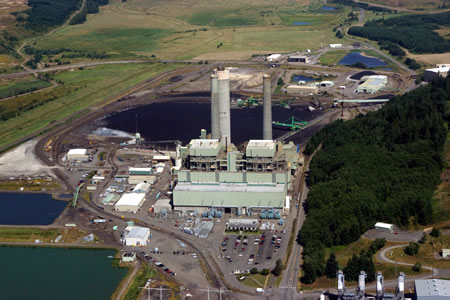
Steam Plant
The general process required grading and planting the disturbed soils. Often these soils were without nutrients and that would make the reclamation process difficult. It was found that biosolids from the Puget Sound area were safe and effective for restoring fertility and organic matter levels quickly. Specialized equipment was developed that could inject biosolids up to 3 feet deep into slots cut through the soil. The slots of biosolids would provide a long term source of plant nutrients and an area where plant roots could reach deep for moisture during the drier summer months.
The biosolids utilization project at the mine was perhaps the largest in the country at the time. It took bio solids from Thurston, Pierce, King and Cowlitz Counties on a year around basis. The biosolids were stored in water tight earthen storage basins during the wetter months and applied to the reclamation area when soils were dry enough to support the application equipment.
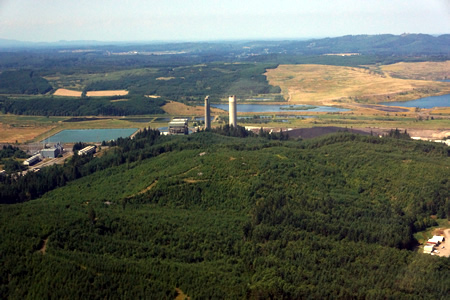
Steam Plant Reclaimed Land
It was here Hickey discovered the potential benefit of recycling biosolids. It was a great program. Erosion from amended sites was eliminated and surface water monitoring confirmed runoff from the sites was clearer and contained less pollutants compared to sites fertilized with inorganic fertilizers. The vegetation is growing as well as it would have if the land had not been disturbed. Because the plant nutrients in biosolids are bound in organic complexes, unlike inorganic fertilizers, they do not leave the site and keep increasing each year as biological processes slowly restore soil structure and internal drainage.
The project was very successful as you can see from the aerial photos on the right.
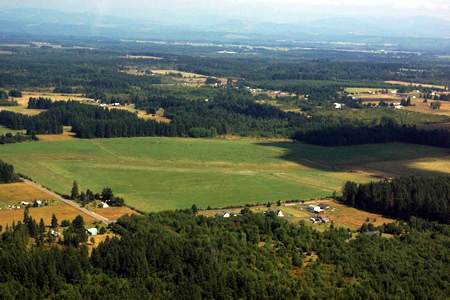
Lewis County Kalberg Ranch
Today there is nothing left of the biosolids utilization project but Douglas fir trees growing along with other native diverse vegetation. When the mine changed ownership in the early 90’s, biosolids use in the land reclamation program at the mine ended. But prior to that time, a biosolids management company was created by the mine owner and managed by Hickey. After several successful years, Roger and his wife Linda decided to buy the small company, name it Bio Recycling Corporation and primarily offer their business services to septic tank pumping companies rather than large municipal treatment plants. “Bio Recycling” was to be the guiding business concept; using plant and soil biological processes to safely and sustainably recycle treated human wastes from septic tanks and small community wastewater treatment plants into plant nutrients and soil organic matter which serves as the base of the food chain for all life.
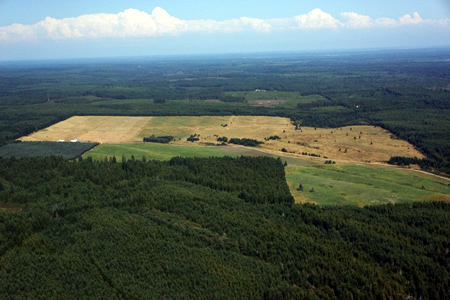
Mason County North Ranch
Our Locations
When Bio Recycling Corporation was formed; both Lewis and Mason counties were struggling with septage management. Neither had public owned treatment plants that were large enough to accommodate the septage volumes generated within the counties and their other options did not meet regulatory requirements. We decided to open septage treatment plants in each county and permit a land application site for each. At both application sites we do regular testing to determine the state of nutrients in the soils and we monitor surface and ground water. Our testing results guide us in balancing the nutrients and minerals to insure a safe and healthy environment and the test results are regularly reported to regulatory authorities.
Our Lewis County plant is located near Centralia and the land application site known as the Kalberg Ranch is 16 miles further south.
Our Mason County location is a completely self contained facility with the plant and ranch land on one 320 acre site. Both plants use screens to remove non-biodegraded trash, grit removal processes and lime stabilization to disinfect and deodorize. The lime stabilization process Bio employs is an EPA approved method for treating septage and even raw sewage to EPA’s Class B standards which ensures it is safe for use as a soil amendment and pasture fertilizer if the site is permitted and operated according to federal and state requirements.
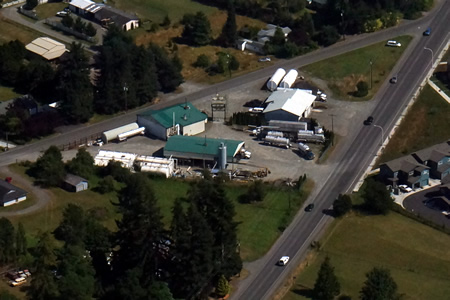
Lewis County Plant
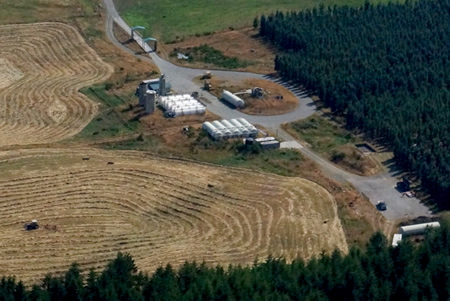
Mason County Plant
